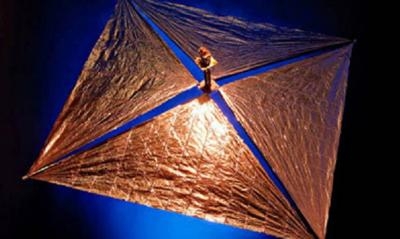Thu, Dec 26, 2013
New Method For Deorbiting Satellites Near First Test Flight
When satellites reach the end of their working lives, they may pose a threat to other spacecraft as they continue to orbit in a dormant state for many decades. But now a new way to deorbit aging satellites in a safe manner is nearing its first test in space. In the future, satellites might carry a packaged ultra-lightweight ‘gossamer sail’ to open as they head towards retirement. The increased aerodynamic drag would pull the craft out of orbit to burn up in the high atmosphere, reducing the risk of catastrophic collisions and creating a sustainable space environment for future generations.

At launch, the Gossamer Deorbit Sail is extremely compact, occupying 15x15x25 cm and weighing only 2 kg. It would expand in minutes to 5x5 m – enough to bring down a satellite of up to 700 kg. A frame of extremely lightweight carbon-fiber booms supports a sail of aluminized Kapton only a few thousandths of a millimeter thick – a fraction of the diameter of human hair.
The sail was developed at the University of Surrey’s Space Centre, funded through ESA’s Advanced Research in Telecommunications Systems program. It is primarily intended for satellites in low orbits, some 700 km up, such as those belonging to Iridium, Orbcomm and Globalstar, who provide satellite phone, low-speed data communications and messaging services. Under the European Code of Conduct for Space Debris Mitigation, created in 2008, ESA is committed to freeing up orbits within 25 years. However, a dormant satellite in 750km altitude without such a sail could remain in orbit for a century or even longer like a speeding bullet endangering new satellites.
In low orbits, there is still sufficient atmosphere to generate the needed drag thanks to the large sail size. Even with the sail, it could take up to 25 years for the satellite to reenter and disintegrate, but to deorbit in the same time frame using traditional thrusters would require ten times the equivalent mass in propellant. For satellites in higher orbits beyond the atmosphere, the sail could potentially use solar radiation pressure to descend with the help of an attitude control system – ‘solar sailing’.
The gossamer sail has been subjected to rigorous testing, including thermal, vibration and vacuum tests. The team hopes to see it validated in orbit using a demonstration satellite by the end of 2014 on a piggy-back launch opportunity. Once in orbit, the sail will be deployed for testing. The initial tests taking 2-3 weeks will demonstrate solar sailing propulsion. After this, the sail will be rotated to increase the effect of atmospheric drag and so deorbit the satellite. At an altitude of 600 km, there is enough atmosphere to cause re-entry and burn up in a mere 2 to 12 months.
The sail would ensure that decommissioned satellites could be retired well within the quarter-century deadline. It could also have other uses, such as deorbiting any adapter that is jettisoned in the course of launching multiple payloads. “The project has been able to show that the design of a low-cost and robust end-of-life deorbiting system not only is possible, but it can also lead to tangible products with a strong commercial interest,” said Professor Vaios Lappas from the University of Surrey.
“The impressive mass-efficiency and atmospheric effectiveness that Surrey Space Centre has achieved for the device will be key for its success in commercial space," said Sven Erb, ESA’s technical officer. "The sail will be an important step in ensuring sustainable exploitation of space in the future.”
(Image provided by ESA)
More News
Airbus Racer Demonstrator Makes Inaugural Flight Airbus Helicopters' ambitious Racer demonstrator has achieved its inaugural flight as part of the Clean Sky 2 initiative, a corners>[...]
A little Bit Quieter, Said Testers, But in the End it's Still a DA40 Diamond Aircraft recently completed a little pilot project with Lufthansa Aviation Training, putting a pair of >[...]
Line Up And Wait (LUAW) Used by ATC to inform a pilot to taxi onto the departure runway to line up and wait. It is not authorization for takeoff. It is used when takeoff clearance >[...]
Contributing To The Accident Was The Pilot’s Use Of Methamphetamine... Analysis: The pilot departed on a local flight to perform low-altitude maneuvers in a nearby desert val>[...]
From 2015 (YouTube Version): Overcoming Obstacles To Achieve Their Dreams… At EAA AirVenture 2015, FedEx arrived with one of their Airbus freight-hauling aircraft and placed>[...]
 Airbus Racer Helicopter Demonstrator First Flight Part of Clean Sky 2 Initiative
Airbus Racer Helicopter Demonstrator First Flight Part of Clean Sky 2 Initiative Diamond's Electric DA40 Finds Fans at Dübendorf
Diamond's Electric DA40 Finds Fans at Dübendorf ANN's Daily Aero-Term (04.23.24): Line Up And Wait (LUAW)
ANN's Daily Aero-Term (04.23.24): Line Up And Wait (LUAW) NTSB Final Report: Extra Flugzeugbau GMBH EA300/L
NTSB Final Report: Extra Flugzeugbau GMBH EA300/L Classic Aero-TV: 'Never Give Up' - Advice From Two of FedEx's Female Captains
Classic Aero-TV: 'Never Give Up' - Advice From Two of FedEx's Female Captains



